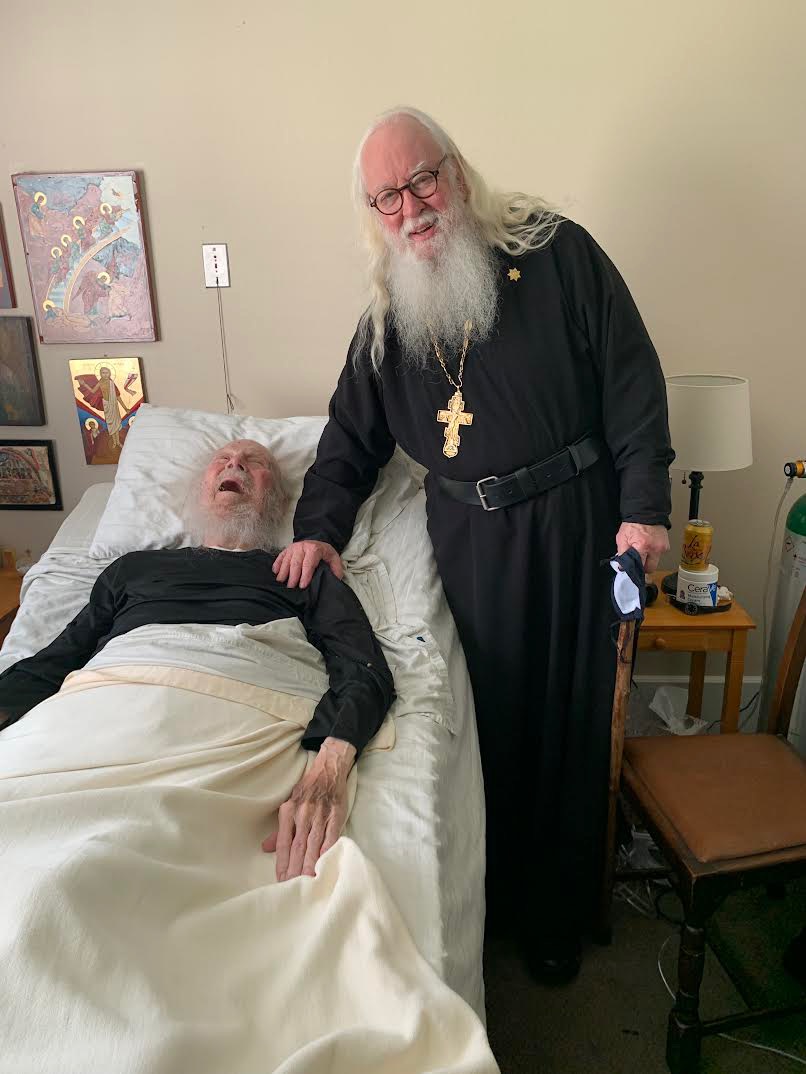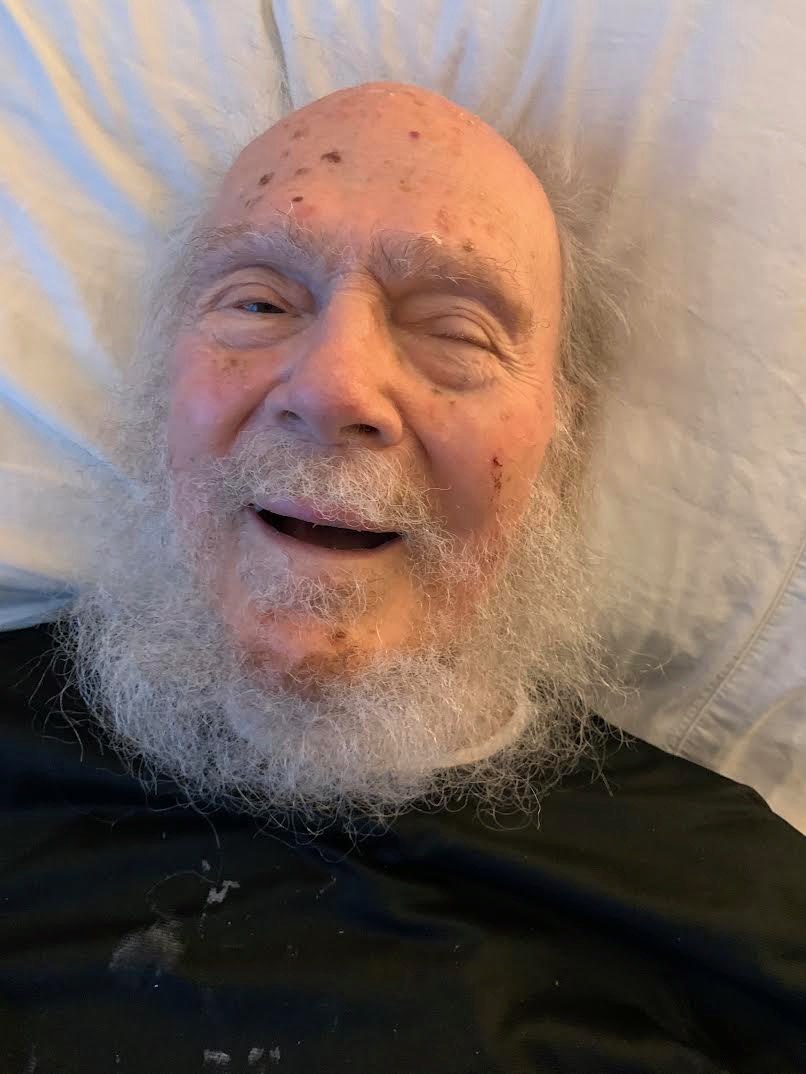Where Heaven and Earth are Joined

Whenever we have non-Orthodox visitors, I am touched by the look on their faces as they gaze for the first time at the sublime, otherworldly, beauty of the interior of our little temple. They are often speechless, just as one would be when seeing a sunset on a warm summer evening. This first glimpse leaves them in a state of silence, as they attempt to process something that seems foreign, yet so familiar. It is as though they have taken a peek into heaven itself, which is really what they are experiencing.
My own first encounter with Orthodoxy took place in the Cathedral of the Holy Virgin, “Joy of All Who Sorrow”, in San Francisco, back in my graduate school days. I remember being overwhelmed, even stunned, by what seemed like a vision of heaven. I came out of the cathedral feeling as though I had just walked into the Old Temple in the Holy City of Jerusalem, and had beheld the Ark itself. The iconostasis did not seem like a barrier between the nave and the altar, but like the veil of the Old Testament temple, shielding me from a holiness that would have been overwhelming, just as was the Ark of the Covenant to the Israelites. Yet this icon screen also seemed to beckon me into the presence of God, like a sign of welcome, affording me a glimpse of God’s Kingdom without laying me low to the ground.
This temple bespoke the truth of the Orthodox teaching that there is no separation between the Church Militant here on earth, and the Church Triumphant in heaven, for here was a place where heaven and earth came together. It was within this temple where the Divine Services gathered mortals, such as myself, and linked us in worship before the Throne of God, joining us to the Cloud of Witnesses, spoken of in the holy scriptures. This truth was exemplified by the icons and frescoes depicting the Cloud of Witnesses, the saints themselves. Their images surrounded me, reminding me that heaven awaits me, and that one day I too can stand before the Father of Lights.
The Orthodox depiction of the saints is a reminder that they stand before us as witnesses, by their lives, to the truth that eternal life is a reality, and that because of Christ’s redemptive act upon the cross, the saints are not dead, but alive, and together we all gaze upon the glory of Christ in the Kingdom of Heaven. The great grace that resides within these depicted saints allows them to embrace the whole world with their love, for they see how we languish in affliction, and they never cease to intercede for us before the Throne of God. They have become our friends in high places, as they await the end of time, when we, too, will stand with them before the Throne of Glory, worshiping the Undivided Trinity.
The saints depicted in the frescoes and icons, having won the good fight, encourage us by their example, and aid us by their prayers, that we, too, become victorious in our battle with the unclean spirits of darkness. Their lives give witness to the importance of living in repentance, and placing Jesus above all else, for it is in Jesus Christ that they have gained eternal life. It is in Jesus Christ that we, like the saints who have gone on before us, have the same promise of immortality. As our friends, they await the day when we will join them, offering their prayers for that end. In gratitude and love, we kiss their holy icons, knowing they are our true friends and family, and that we are united with them as one, in Christ Jesus Our Lord.
With love in Christ,
Abbot Tryphon

Photos: I’ve been in Portland, Oregon, for the past few days at the side of my close friend and confessor, Hieromonk Andrew (Nicholas Letten). At ninety-six years of age, Father Andrew is exactly 20 years my senior, with his birthday on November 8th, and mine on November 9th. His friendship has meant a great deal to me, and I will sorely miss him when he reposes, which is likely very soon. The photo of the two of us together was taken just after I told him the saints in heaven will know he’s arrived when they hear his laugh (thus the laugh on his face). Everyone who has known Father Andrew knows that he is one of the most joyful people around, and his spontaneous laugh has brought joy to all of us who have known him. Yesterday my friend, Father Matthew Tate, rector of Annunciation Orthodox Church in Milwaukie, Oregon, where Father Andrew was attached, was there at his bedside, giving him Holy Communion, and saying the prayers for the end of life.

Friday January 21, 2022 / January 8, 2022
31st Week after Pentecost. Tone five.
Fast. Fish Allowed
St. George the Chozebite, abbot (7th c.) and St. Emilian Bishop of Cyzicus (9th c.).
Venerable Domnica of Constantinople (395).
Venerable Gregory, wonderworker of the Kiev Caves (1093).
Venerable Gregory, hermit of the Kiev Caves (14th c.).
Hieromartyr Isidore and 72 companions at Yuriev (Dorpats) in Estonia, slain by the Latins in 1472.
New Hieromartyr Victor priest (1937).
New Hieromartyrs Demetrius, Vladimir priests, Paphnutius, Martyr Michael (1938).
New Hieromartyr Basil priest (1939).
Martyr John (1940).
St. Michael confessor, priest (1941).
Venerable Paisius of Uglich (1504).
Hieromartyr Carterius of Caesarea in Cappadocia (304).
Martyrs Theophilus the Deacon and Helladius in Libya (4th c.).
Martyrs Julian and his wife Basilissa, and with them Marcionilla and her son Celsus, Anthony, Anastasius, seven children, and twenty soldiers, at Antinoe in Egypt (313).
Venerable Elias the Hermit of Egypt (4th c.).
Martyr Abo the Perfumer of Baghdad, who suffered at Tbilisi, Georgia (786) (Georgia).
Sts. Atticus (425) and Cyrus (714), patriarchs of Constantinople.
Venerable Agatho of Egypt, monk (4th c.)
Holy Virgin Gudula of Brussels (659) (Celtic & British).
St. Gregory of Ochrid, bishop of Moesia (1012) (Bulgaria).
St. Severinus, apostle of Noricum, Austria (482).
St. Theodore of Constantinople (595).
St. Erhard, bishop of Regensburg (Bavaria) (700).
St. Emilian the Confessor, bishop of Cyzicus (9th c.).
St. Macarius (Macres) of Vatopedi, Mt. Athos (1431).
St. Severin, bishop of Cologne (397).
St. Nathalan of Aberdeenshire.
St. Pega, hermitess, of Peakirk.
St. Wulsin, bishop of Sherborne.
The Scripture Readings
James 2:1-13
Beware of Personal Favoritism
2 My brethren, do not hold the faith of our Lord Jesus Christ, the Lord of glory, with partiality. 2 For if there should come into your assembly a man with gold rings, in fine apparel, and there should also come in a poor man in filthy clothes, 3 and you pay attention to the one wearing the fine clothes and say to him, “You sit here in a good place,” and say to the poor man, “You stand there,” or, “Sit here at my footstool,” 4 have you not shown partiality among yourselves, and become judges with evil thoughts?
5 Listen, my beloved brethren: Has God not chosen the poor of this world to be rich in faith and heirs of the kingdom which He promised to those who love Him? 6 But you have dishonored the poor man. Do not the rich oppress you and drag you into the courts? 7 Do they not blaspheme that noble name by which you are called?
8 If you really fulfill the royal law according to the Scripture, “You shall love your neighbor as yourself,” you do well; 9 but if you show partiality, you commit sin, and are convicted by the law as transgressors. 10 For whoever shall keep the whole law, and yet stumble in one point, he is guilty of all. 11 For He who said, “Do not commit adultery,” also said, “Do not murder.” Now if you do not commit adultery, but you do murder, you have become a transgressor of the law. 12 So speak and so do as those who will be judged by the law of liberty. 13 For judgment is without mercy to the one who has shown no mercy. Mercy triumphs over judgment.
Mark 13:1-8
Jesus Predicts the Destruction of the Temple
13 Then as He went out of the temple, one of His disciples said to Him, “Teacher, see what manner of stones and what buildings are here!”
2 And Jesus answered and said to him, “Do you see these great buildings? Not one stone shall be left upon another, that shall not be thrown down.”
The Signs of the Times and the End of the Age
3 Now as He sat on the Mount of Olives opposite the temple, Peter, James, John, and Andrew asked Him privately, 4 “Tell us, when will these things be? And what will be the sign when all these things will be fulfilled?”
5 And Jesus, answering them, began to say: “Take heed that no one deceives you. 6 For many will come in My name, saying, ‘I am He,’ and will deceive many. 7 But when you hear of wars and rumors of wars, do not be troubled; for such things must happen, but the end is not yet. 8 For nation will rise against nation, and kingdom against kingdom. And there will be earthquakes in various places, and there will be famines and troubles. These are the beginnings of sorrows.
